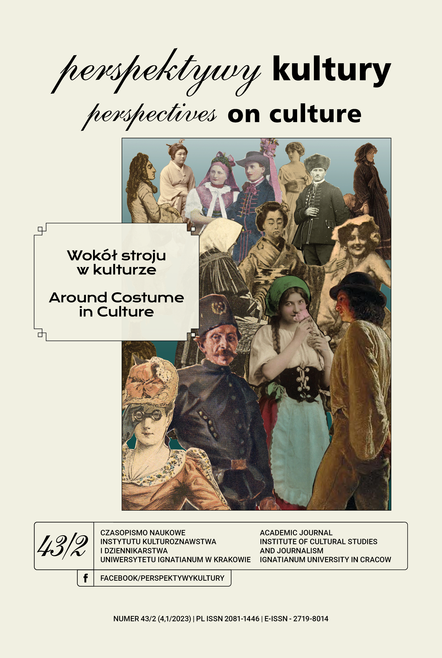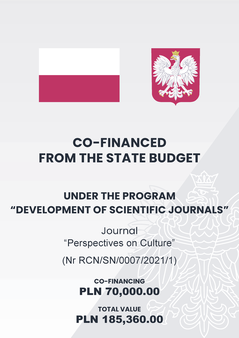Miner Uniform – Clothing or Costume?
Cultural Heritage and Politics
Abstract
The article discusses the function of the uniform from the 17th to the 21st century among Upper Silesian coal miners. It analyzes its role as a text of culture and a tool according to the semiotic approach, and in addition as an element of cultural heritage. The miner uniform was created as a costume in the early 18th century, but it became a corporate garment within half a century. It was a tool for those in power to control and de-individualize miners as a social group. Until the 1990s, it exposed the political connotations of this heritage item. With the liberalization of the economy, the uniform was excluded from the Authorized Heritage Discourse, which translated into a loss of prestige. Wearing it became an act of the individual to reveal their miner’s identity.
References
Agricola, G. (1556). De Re Metallica Libri XII. Basilae. Pozyskano z: https://www.gutenberg.org/files/38015/38015-h/38015-h.htm (dostęp 21.08.2023).
Bax K. (1942). Der deutsche Bergmann im Wandel der Geschichte, seine Stellung in der Gegenwart und die Frage seines Berufsnachwuchses. Berlin: Verlag von Wilhelm Ernst & Sohn.
Carnall v.R. (1854). Das Denkmal des Staats- Minister Grafen von Reden bei der Königshütte in Oberschlesien. Berlin: J.F. Starcke. Pozyskano z: https://sbc.org.pl/dlibra/publication/220781/edition/208615/content (dostęp 31.08.2023).
Cyrankiewicz J. (1949). Górnicy to czołowi żołnierze Polski Ludowej na froncie walki o lepszą przyszłość dla całego narodu. Górnik. Organ ZZG, nr 22, 7.
Drechsler P. (1909). Bergbau und Bergmannsleben in Schlesien. Ein Lesebuch für den schlesischen Bergmann. Kattowitz: Verlag von Gebrüder Böhm. Pozyskano z: https://sbc.org.pl/dlibra/publication/15605/edition/13920/content (dostęp 31.08.2023).
Dünbier O. (1936). Der Kumpel. Von Sitte, Brauch und Sprache des deutschen Bergmanns. Bd. 3. Düsseldorf: Be-Vau Verlag GmbH.
Heilfurth, G. (1981). Der Bergbau und seine Kultur. Eine Welt zwischen Dunkel und Licht. Zürich: Atlantis.
Hertz C. (2006). The Uniform: as Material, as Symbol, as Negotiated Object. Midwestern Folklore, Journal of the Hoosier Folklore Society, Vol. 32 (1/2), 43-58. Pozyskano z: https://www.academia.edu/4044048/The_Uniform_As_Material_As_Symbol_As_Negotiated_Object (dostęp 03.08.2023).
Jedynak, Z. (2004). Śląskie mundury górnicze z początku XIX wieku. W: A. Złoty (red.), Moja ziemia – Katowice. Katowice: Bractwo Gospodarcze Związku Górnośląskiego, 41.
Kołakowski, K., Piecha-van Schagen, B. (2019) Czas wolny w kulturze współczesnej (po 1989 roku). W: D. Świtała-Trybek o B. Piecha-van Schagen (red.), Czas wolny górników węgla kamiennego na Górnym Śląsku. Po pracy coś trzeba było robić. Zabrze: Muzeum Górnictwa Węglowego w Zabrzu, 385-397.
Łuczak, J. (1972). Niecodzienne historie – Fidel Castro na Śląsku. Pozyskano z: https://cyfrowa.tvp.pl/video/niecodzienne-historie,fidel-castro-na-slasku,64205058 (dostęp 11.08.2023).
Lüttig, O. (1937). Kohlenwirtschaftsorganisationen. Berlin: Verlag Julius Springer.
Mainka, K.F. (2019). Nie ma, nie ma, jak to bergmankowi. Osprowki górnicze i tarnogórskie z lat 1921-1936. Tarnowskie Góry: Stowarzyszenie Miłośników Ziemi Tarnogórskiej.
Marx, B. (2008). From Protestant Fortress to Baroque Apotheosis: Dresden from the Sixteenth to the Eighteenth Century. W: G.B. Cohen i F.A.J. Szabo (ed.), Embodiments of Power. Nowy Jork: Berghahn Books, 120-163.
Peoples, S., (2014). Embodying the military: Uniforms. Critical Studies in Men’s Fashion, Vol. 1 (1), 7-21. DOI: 10.1386/csmf.1.1.7_1. Pozyskano z: https://openresearch-repository.anu.edu.au/bitstream/1885/29269/2/01_Peoples_Embodying_the_Military:_2014.pdf (dostęp 4.08.2023).
Perlick A. (1943). Volkskunde des Arbeiterstandes im obeschlesischen Industrieraume. W: A. Perlick (red.) Landeskunde des Oberschlesischen Industriegebietes. Ein heimatwissenschaftlisches Handbuch. Breslau: Schlesien-Verlag, 252-299.
Piecha-van Schagen, B. (2016). Mundur górniczy to zaszczyt. W: B. Linek (red.), Narracje górnicze z terenu Zabrza. Kopalnia to je do mie wszystko. Zabrze: Muzeum Górnictwa Węglowego w Zabrzu, 221-244.
Pratt, M.G., Rafaeli A. (1997). Organizational Dress as a Symbol of Multilayered Social Identities. The Academy of Management Journal, Vol. 40 (4), 862-898. Pozyskano z: https://www.jstor.org/stable/256951 (dostęp 4.08.2023).
Preidl, W., Wójcik, A.J. (2012). Polski mundur górniczy – tradycja i współczesność. W: P.P. Zagożdżon i M. Madziarz (red.), Dzieje górnictwa – element europejskiego dziedzictwa kultury. Wrocław: Oficyna Wydawnicza Politechniki Wrocławskiej, 315-338.
Smith, L. (2006). Uses of Heritage. Abingdon: Routledge.
Uspienski, B. (1998). Historia i semiotyka. Gdańsk: Słowo / Obraz Terytoria.
Więckowska, J. (1996). „Chcąc rozszyfrować przesłanie” – mundur górniczy Iwaszkiewicza na tle jego życia i twórczości. Prace Polonistyczne, Nr 51, 135-161.
Wray, D. (2011). Images, icons and artefacts: maintaining an industrial culture in a post-industrial environment. W: L. Smith, P.A. Schackel i G. Campbell (red.), Heritage, labour and working classes. Abingdon: Routledge.
Zaleski W. (2018). Dzieje górnictwa i hutnictwa na Górnym Śląsku do roku 1806. Szczęsne: Klinika języka.
Friedrich Wilhelm II von Hohenzollern Król Prus. Revidierte Bergordnung für das souvereine Herzogthum Schlesien und für die Grafschaft Glatz z 5 czerwca 1769.
Friedrich Wilhelm III von Hohenzollern Król Prus. Reglement wegen der unmittelbar angeordneten Civil Uniformen für die Provinzial Landes Collegia z 14 lutego 1804.
Franz Joseph I Cesarz Austrii, Król Węgier i Czech. Verordnung des Ackerbauministeriums im Einvernehmen mit dem Ministerium des Innern, betreffend die Uniformierung der k. k. Forst- und Bergbeamten z 14 lipca 1890. Pozyskano z: https://alex.onb.ac.at/cgi-content/alex?aid=rgb&datum=1890&page=299&size=45 (dostęp 2.08.2023).
Wilhelm II von Preußen Cesarz Niemiec i Król Prus. Allerhöchster Erlaß vom 15 Januar 1890, betreffend die Uniform der Beamten der Preußischen Staats , Berg , Hütten- und Salinenverwaltung z 15 stycznia 1890. Pozyskano z: https://www.digitale-sammlungen.de/en/view/bsb11558101?q=%28Zeitschrift+f%C3%BCr+das+Berg-,+H%C3%BCtten-+und+Salinenwesen,+1890%29&page=2,3 (dostęp 2.08.2023).
Minister Przemysłu i Pracy Prus. Vorschriften über die bergmännische Kleidung z 5 marca 1934.
Prezes Rady Ministrów. Uchwała Rady Ministrów z dnia 30 listopada 1949 r. w sprawie szczególnych przywilejów dla górników w górnictwie węglowym. Pozyskano z: https://isap.sejm.gov.pl/isap.nsf/download.xsp/WMP19491001175/O/M19491175.pdf (dostęp 10.08.2023).
Prezes Rady Ministrów. Rozporządzenie Rady Ministrów z dnia 28 listopada 2001 r. w sprawie ustanowienia odznaki honorowej „Zasłużony dla Górnictwa RP”, ustalenia jej wzoru, zasad i trybu nadawania oraz sposobu noszenia. Pozyskano z: https://isap.sejm.gov.pl/isap.nsf/download.xsp/WDU20011411587/O/D20011587.pdf (dostęp 10.08.2023).
[List informujący o karze nałożonej na kowala Hungera przez Gottlieba Kalidego]. (1797). Królewski Urząd Górniczy w Tarnowskich Górach 323. Katowice: Archiwum Państwowe w Katowicach.
Copyright (c) 2023 Perspectives on Culture

This work is licensed under a Creative Commons Attribution 4.0 International License.
Autor, zgłaszając swój artykuł, wyraża zgodę na korzystanie przez Wydawnictwo Uniwersystet Ignatianum z utworu na następujących polach eksploatacji:
- utrwalania utworu w formie papierowej, a także na nośniku cyfrowym lub magnetycznym;
- zwielokrotnienia utworu dowolną techniką, bez ograniczenia ilości wydań i liczby egzemplarzy;
- rozpowszechniania utworu i jego zwielokrotnionych egzemplarzy na jakimkolwiek nośniku, w tym wprowadzenia do obrotu, sprzedaży, użyczenia, najmu;
- wprowadzenia utworu do pamięci komputera;
- rozpowszechniania utworu w sieciach informatycznych, w tym w sieci Internet;
- publicznego wykonania, wystawienia, wyświetlenia, odtworzenia oraz nadawania i reemitowania, a także publicznego udostępniania utworu w taki sposób, aby każdy mógł mieć do niego dostęp w miejscu i czasie przez siebie wybranym.
Wydawca zobowiązuje się szanować osobiste prawa autorskie do utworu.






